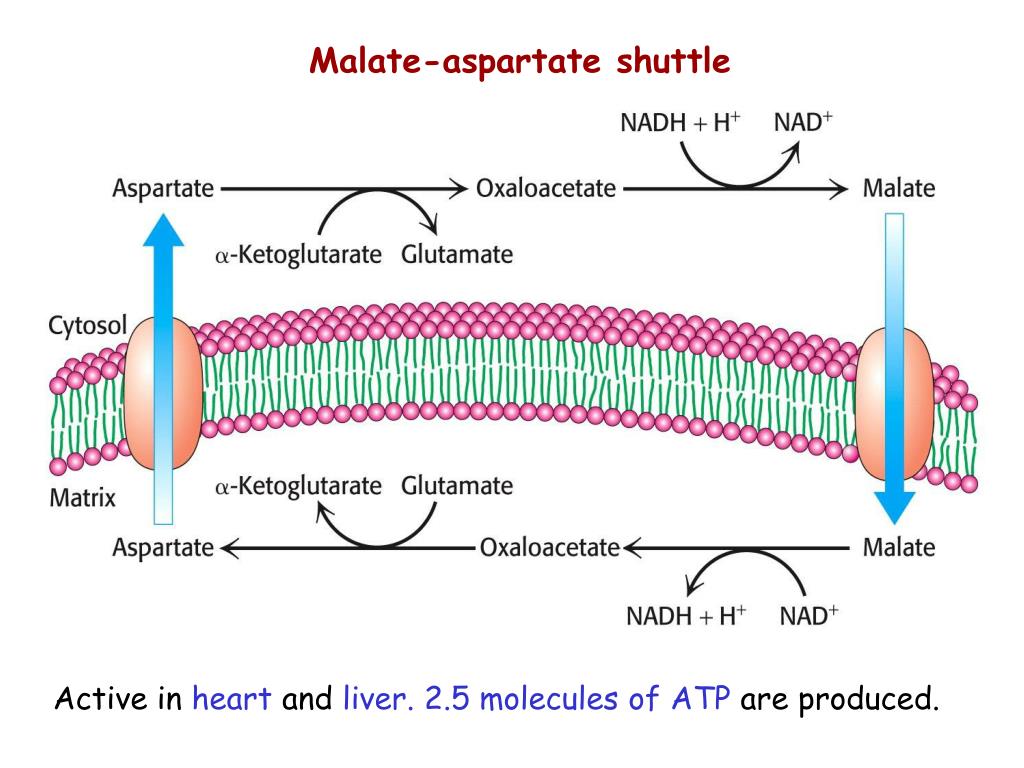

in the malateaspartate shuttle for example success of the shuttle requires. The appearance of advertisements or/and product references in the publication is not a warranty, endorsement, or approval of the products or services advertised or of their effectiveness, quality or safety. Related to Malate-aspartate shuttle: glycerophosphate shuttle, Glycerol phosphate shuttle. Essentially, the shuttles involve the reoxidation of NADH coupled to the. It is present in insect flight muscle and in white muscle. This is particularly important when the recommended agent is a new and/or infrequently employed drug.ĭisclaimer: The statements, opinions and data contained in this publication are solely those of the individual authors and contributors and not of the publishers and the editor(s). Malate-aspartate shuttle Glycerophosphate shuttle: This shuttle system is not much common to be used in humans. The mitochondrial malate aspartate shuttle system (MAS) maintains the cytosolic NAD+/NADH redox balance, thereby sustaining cytosolic redox-dependent.

However, in view of ongoing research, changes in government regulations, and the constant flow of information relating to drug therapy and drug reactions, the reader is urged to check the package insert for each drug for any changes in indications and dosage and for added warnings and precautions. No part of this publication may be translated into other languages, reproduced or utilized in any form or by any means, electronic or mechanical, including photocopying, recording, microcopying, or by any information storage and retrieval system, without permission in writing from the publisher.ĭrug Dosage: The authors and the publisher have exerted every effort to ensure that drug selection and dosage set forth in this text are in accord with current recommendations and practice at the time of publication. The capacity of the various tumor lines for the reoxidation of cytoplasmic NADH via the malate-aspartate shuttle approaches 20% of the total respiratory rate of the cells and thus appears to be sufficient to account for the mitochondrial reoxidation of that fraction of glycolytic NADH not reoxidized by pyruvate and lactate dehydrognenase in the cytoplasm.Copyright: All rights reserved. The maximal rate of the malate-aspartate shuttle was established by addtion of arsenite to inhibit the mitochondrial oxidation of the pyruvate formed from added lactate. Compounds that inhibit the carrier-mediated entry of malate into mitochondria, such as butylmalonate, benzenetricarboxylate, and iodobenzylmalonate, also inhibited the accumulation of pyruvate from added L-lactate by the tumor cells. Enter the email address you signed up with and well email you a reset. The involvement of the respiratory chain in the reoxidation of cytoplasmic NADH was demonstrated by the action of cyanide, rotenone, and antimycin A, which strongly inhibited the formation of pyruvate from added L-lactate. The malate/aspartate shuttle and pyruvate kinase as targets involved in the stimulation of gluconeogenesis by phenylephrine. The goals of this study were to determine the time course of the postnatal decline and to identify potential regulatory sites by measuring steady-state myocardial mRNA and protein levels of the mitochondrial proteins involved in the shuttle. Reoxidation of cytoplasmic NADH thus generated was completely inhibited by the transaminase inhibitor aminooxyacetate. Developmental downregulation of the malate-aspartate shuttle has been observed in cardiac mitochondria. All the tumor cells examined showed mitochondrial reoxidation of cytoplasmic NADH, as evidenced by the accumulation of pyruvate when the cells were incubated aerobically with L-lactate. The activity of the malate-aspartate shuttle for the reoxidation of cytoplasmic reduced nicotinamide adenine dinucleotide (NADH) by mitochondria was assessed in six lines of rodent ascites tumor cells (two strains of Ehrlich ascites carcinoma, Krebs II carcinoma, Novikoff hepatoma, AS-30D hepatoma, and L1210 mouse leukemia).


 0 kommentar(er)
0 kommentar(er)
